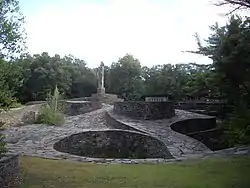Opus 40
Opus 40 is a large environmental sculpture in Saugerties, New York, created by sculptor and quarryman Harvey Fite (1903—1976). It comprises a sprawling series of dry-stone ramps, pedestals and platforms covering 6.5 acres (2.6 ha) of a bluestone quarry.[2]
Opus 40 | |
 | |
  | |
| Location | Fite Rd., Saugerties, NY |
|---|---|
| Coordinates | 42.050212°N 74.031544°W |
| Area | 14.1 acres (5.7 ha) |
| Built | 1939 |
| Architect | Harvey Fite |
| NRHP reference No. | 01000238[1] |
| Added to NRHP | March 12, 2001 |
Overview
.jpg.webp)
Fite, then a professor of sculpture and theater at Bard College, Annandale-on-Hudson, New York, purchased the disused quarry site in 1938, expecting to use it as a source of raw stone for his representational sculpture. Instead, inspired by a season of work restoring Mayan ruins in Honduras, he began creating a space to display the large carved statues he was beginning to create out of native bluestone.[2]
Using the rubble that had been left behind as the area was quarried, he built terraces, ramps and walkways to lead to the individual works, doing all the work by hand, and using the traditional hand tools that had been used by the local quarrymen before him. As the rampwork expanded, Fite realized that the 1.5-ton (1.36 tonne) statue, Flame, which had occupied the central pedestal, had become too small for the scale to which his work had grown, and he replaced it with a 9-ton bluestone pillar which he had found in a nearby streambed. This happened in 1964, more than 20 years after he had begun work on his quarry.
Fite had originally planned to carve the new stone in place (Flame had been carved in Fite's studio), but once the stone was up, he realized that what he had originally conceived as a setting for sculpture had become a sculpture in its own right, and a new kind of sculpture, in which carved representational work was out of place. So he removed the other carved pieces, relocating them on the grounds nearby, and continued to work on this new sculptural concept for the rest of his life.[2]
In the early 1970s, after he had retired from 30 years as a professor at Bard College, Fite built the Quarryman's Museum on the grounds—a collection of folk tools and artifacts of the quarrying era.[2] It was around this same time that he finally succumbed to the pressure to give his masterwork a name. At first a joke -- “Classical composers don’t have to name things,” he would say, “they can just number them, Opus One, Opus Two, and so on”—he eventually arrived at what was certainly an apropos name. Opus is the Latin word for work, and 40 refers to the number of years he expected he would need to complete the work.[2]
Fite died in 1976, in the 37th year of his creation. He died working on it, in a fall. He left some unfinished areas—but, as his stepson, the writer Jonathan Richards, has observed, “Opus 40 is as complete as it ever would have been. It was the product of Fite’s ceaseless vision, and could only have been stopped by his death.”[2] The following year, his widow, Barbara Fite, who had been a close aesthetic collaborator with him throughout his labors, created a nonprofit group to administer Opus 40, and opened it to the public. Barbara Fite died in 1986, and her family continues to administer the organization. Opus 40 remains a popular tourist attraction, as well as a wedding and concert venue.[2] In 2001 it was added to the National Register of Historic Places.[1]
Brendan Gill, in the March 1989 edition of Architectural Digest, called Opus 40 "one of the largest and most beguiling works of art on the entire continent," and he has also called it “the greatest earthwork sculpture I have ever seen.” Though Fite was not associated with the Land Art or Earthworks sculptural movement of the 1970s, he came to be known as a pioneer of that movement, and was recognized in 1977 by the Hirshhorn Museum of the Smithsonian Institution, in a show entitled “Probing the Earth: Contemporary Land Projects,” as a forefather of the earthworks movement.
Tributes
- A Sonny Rollins concert at Opus 40 on August 16, 1986 was filmed for Robert Mugge's documentary Saxophone Colossus.
- The band Mercury Rev recorded "Opus 40", a song about the site, on their 1998 album Deserter's Songs.
- The music video for Amanda Palmer's interpretation of Pink Floyd's "Mother" was filmed at Opus 40 in 2017.
References
- "National Register Information System". National Register of Historic Places. National Park Service. July 9, 2010.
- "Cultural Resource Information System (CRIS)". New York State Office of Parks, Recreation and Historic Preservation. Archived from the original (Searchable database) on 2015-07-01. Retrieved 2016-03-01. Note: This includes John A. Bonafide (October 2000). "National Register of Historic Places Registration Form: Opus 40" (PDF). Retrieved 2016-03-01. and Accompanying photographs
Further reading
- Wallis, David (June 2, 2006). "A Monumental Vision of Half a Lifetime". The New York Times.

